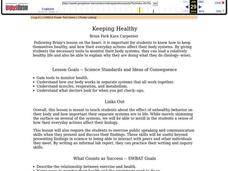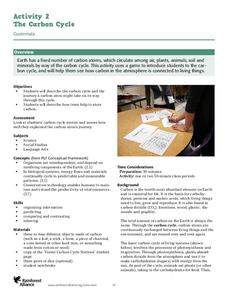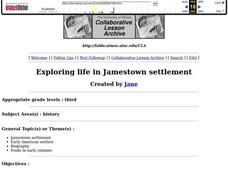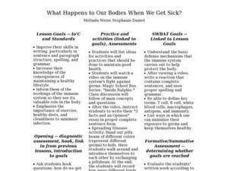Curated OER
Keeping Healthy
Students describe the relationship between exercise and health. They name ways to monitor their health and the equipment used to do so. Students name solutions to common health issues and explain why good nutrition and exercise are...
Curated OER
An Introduction to Microbes - Biology Teaching Thesis
Students are able to define microbes and identify the five main groups of microbes. They are able to give examples of ways in which microbes have impacted or currently impact human life. Students are able to explain that not all microbes...
Curated OER
Population Biology - Biology Teaching Thesis
Learners explore the effects of different density-dependent and density-independent factors on population growth. They explore how the interactions of organisms can affect population growth. Students explore the pattern of population...
Curated OER
Keeping Your Heart in Good Shape: What are the Benefits? - Biology Teaching Thesis
Learners name the main parts of the heart and what events occur there. They write a reaction that contains complete sentences, and uses proper spelling and grammar, after viewing a video. Students define the following terms: contraction,...
It's About Time
Identifying Matter
High schoolers test wood splints that have been soaked in mystery solutions to identify the different colors it produces when lit. The lesson concludes with a reading passage and analysis questions.
Rainforest Alliance
The Carbon Cycle
Scholars learn about the carbon cycle, play a carbon cycle game, and then write a story based on their role as a carbon atom during the game. After the writings, pupils analyze the carbon cycle by leading a class discussion on the material.
LABScI
Population Dynamics: The Predator-Prey Lab
Wolves eat better when the bunny population increases, but how long does that last? A series of 12 biology lessons uses the sixth installment to explore the predator-prey relationship between bunny and wolf populations. Young scientists...
LABScI
Acids and Bases: Cabbage Juice pH Indicator
Explore the range of pH using an assortment of household liquids. Scholars create their own pH indicators from cabbage and determine the pH of several liquids. To further their exploration, individuals use the same liquids to create...
Curated OER
Slurrp
In this agriculture worksheet, students find the facts needed to construct a website focused around giving information about products that are made from corn.
Curated OER
Exploring Life in Jamestown Settlement
Third graders examine life in early colonial settlements. Students investigate what settlers ate and create a menu for a fictitious restaurant in a settlement.
Curated OER
Eating for Your Future
Students brainstorm ways to live healthy. In this health science lesson, students recipes that are healthy and appealing. They compile all recipes and develop a class cookbook.
Curated OER
Cafe: ESL Vocabulary
In this ESL cafe menu vocabulary worksheet, students analyze 7 pictures that depict items that might be on a menu. Students match the pictures with the words that describe them.
Curated OER
Pizza and the Economy
Learners become aware of the history behind pizza and how it was adapted to the economic and geographic conditions of the United States. They have a basic understanding of the concepts of supply and demand.
Curated OER
From There To Here...
Students find out where some of the products in hour homes come from, then become aware of our local trash, landfills and incinerators. They chart and graph data and use maps for different purposes.
University of Georgia
Resumé of an Element
Class members use the provided worksheet to create a resume for one element from the periodic table. The activity teaches learners about all of the properties of elements and how to read the periodic table.
Curated OER
Spice Up Your Life
Second graders identify major spices found in the world. They link spices with countries they are grown in and the uses for these valuable items.
Curated OER
Ears Here!
Students participate in an interactive video to review the five senses. They perform hands-on activities to test their sense of hearing and play a hearing game from the Internet.
Curated OER
WET Science Lesson #11: How Light Affects Water
Scientists listen to the story of Wadja Egnankou who works to save African mangrove forests. They experiment with refraction and the introduction of particulate matter to water. They conclude with creative writing about the need for a...
Curated OER
Soil Porosity, Moisture Content, pH, and Density
This lab activity does not have to be done with AP environmental scientists. It can also be done with middle to high school earth scientists. The procedures aren't complex. Learners determine the density of dry and wet sand in order to...
Curated OER
What Happens to Our Bodies When We Get Sick?
Seventh graders explore ways in which they become sick. They find out ways that there bodies fight off bacteria. Students watch a video from the Magic School Bus series:"Inside Raphie." After reviewing video students can openly discuss...
Curated OER
Population Biology
Students define the following terms: predation, competition, carrying capacity and population. They can explain the patterns of growth and the limitations of growth. Students explain the difference between density-dependent and...
Curated OER
Fusion Confusion
High schoolers are introduced to three types of energy transfer: conduction, convection, and radiation. They model the scientific process of fusion to become with the sun and how it produces energy.
Curated OER
Watch Them Grow
Students explore the growth of plants and animals. Through research and observation, students create a habitat for specific plans and animals. As a group, they examine the similarities and differences of living things. Students identify...
Curated OER
Water Filtration
Students demonstrate the four of five procedures that municipal water plants use to purify water for drinking. A water filtration system is designed by a student and their partner. A data chart is made to record all observations when the...

























